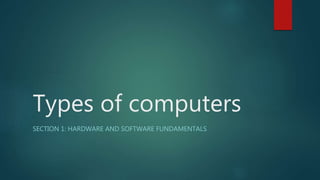
Types of computers
- 1. Types of computers SECTION 1: HARDWARE AND SOFTWARE FUNDAMENTALS
- 2. Objectives Define the following terms: Supercomputer, Mainframe, Microcomputer, Minicomputer, Server, Workstations, Stand Alone Identify, sort and briefly explain the types of Computers based on storage and processing capacity Describe the characteristics/functions of each type of computer Briefly discuss where each type of computer is applicable
- 3. What is a computer? A computer is a machine that can be programmed to manipulate symbols. Its principal characteristics are: It responds to a specific set of instructions in a well-defined manner. It can execute a prerecorded list of instructions (a program). It can quickly store and retrieve large amounts of data. All computers must be able to gather and process data, store, disseminate and display information
- 5. types of computers Computers are categorized based on their storage capacity, processing power, cost and uses. There are Eight main Categories: Mobile computers Microcomputers Workstation Minicomputers Server Mainframe Computers Supercomputers Special-Purpose Computer
- 6. Mobile computers They are single user computers. They are super small and mobile. They are meant to be carried around and taken from place to place.
- 7. Microcomputers They are single user computers. They run on microprocessors in their central processing units. They are much, much cheaper than supercomputers, mainframe computers and even minicomputers. They posses a smaller storage capacity and have a slower processing speed than supercomputers, mainframe computers. They’re meant for everyday uses that are more practical than professional.
- 8. Workstations It is a desktop computer with a more powerful processor, additional memory and enhanced capabilities It performs a special group of task, such as 3D Graphics or game development. It may use multiple screens to enhance their viewing. It is a applicable in the use of engineering applications (CAD/CAM), desktop publishing, software development, other types of applications that require a moderate amount of computing power and relatively high quality graphics capabilities.
- 9. Workstations Workstations generally come with: a large, high-resolution graphics screen, large amounts of RAM, built-in network support, and a graphical user interface. Most have a mass storage device such as a disk drive, Special types of workstations, called a diskless workstation, comes without a disk drive. The most common operating systems for them are UNIX and Windows NT. Workstations are single-user computers. Workstations are typically linked together to form a local-area network, but they can also be used as stand-alone systems.
- 10. Minicomputers A minicomputer is a multiprocessing machine that can support up to about 200 users at the same time. It’s like a less powerful mainframe computer, and is about the size of a refrigerator. A server can be an example of a minicomputer, but not all servers are minicomputers. Due to the ways microcomputers have excelled in processing power even beyond minicomputers, and at a much smaller size, minicomputers have become pretty much obsolete. Some examples: K-202, Texas Instrument TI-990, SDS-92, IBM Midrange computers
- 11. Servers A computer or device on a network that manages network resources. There are many different types of servers. File server: a computer and storage device dedicated to storing files. Any user on the network can store files on the server. Print server: a computer that manages one or more printers, and a network server is a computer that manages network traffic. Database server: a computer system that processes database queries. Web server: are computers that deliver (serves up) Web pages.
- 12. Mainframe They are multi-user computers They can handle more than 1000 (>1000) users at a time. They are huge, towering machines with lots of processing power. Mainframe computers are mostly used by corporations, government agencies, and banks – organizations that need a way to store large quantities of information such as censuses. The processing capabilities of mainframe computers are measured in MIPS, or millions of instructions per second. Some examples: Fujitsu’s ICL VME, Hitachi’s Z800
- 13. Supercomputers It’s a term used to describe computers that have the most capable processing power of its time. Today, modern supercomputers run hundreds of thousands of processors, capable of computing quadrillions of calculations in just a few nanoseconds. They are used in computational science to calculate and carry out a plethora of complex tasks. Modeling molecular structures, weather forecasting, and the field of quantum mechanics, among others, rely on supercomputers and their intense processing power to solve their equations. The processing capabilities of Supercomputers are measured in FLOPS, or floating point operations per seconds. Some prominent examples of supercomputers include the Jaguar, Nebulae, Roadrunner, Kraken, Jugene, Pleiades and the Tianhe-2
- 14. Special-purpose Computers Special-purpose computers refer to computers that are built to perform specific tasks, such as automatic teller machines or washing machines. Special-purpose computers also include systems to control military planes, boats, surveillance equipment and other defense-oriented applications. They utilize unique operating systems that are tailored to performing their specific functions. Special-purpose computers possess a logical structure and data input-output devices that are built to solve strictly-defined issues in an efficient manner.
- 15. Special-purpose Computers Special-purpose computers utilize embedded systems or other unique operating platforms to work independently of other functions. Other examples of special purpose computers include traffic-light control systems, weather-forecasting simulators, oil-exploration systems and traffic-control computers. These computer systems share similar features, but their design aims to fulfill a distinct role. They perform a singular function, allowing them to eliminate excess memory and the amount of information that can be submitted into it. This allows special-purpose computers to operate at heightened speeds to complete their task.
- 16. Hierarchy of computer types Computer Single User Workstations Personal/micro- Computer Desktop Game consoles Smart TVs Mobile Computers Laptops Netbooks Tablets Handheld Game Console Calculators Portable media players Cellphones and smartphones Wearables Multi-user Minicomputer Mainframe Servers Supercomputer Special Computers Embedded Computers
